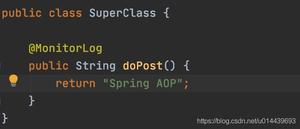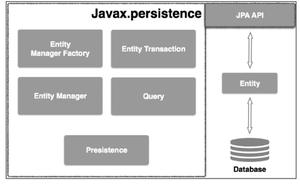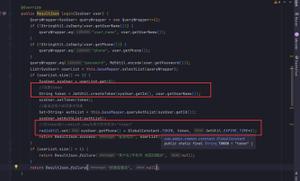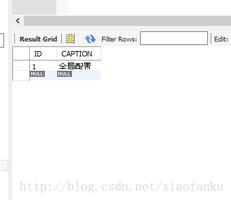Spring 自定义注解,结合AOP,配置简单日志注解 (转)
本文内容纲要:
- 一、创建自定义注解- 二、解析注解
- 三、使用自定义注解
java在jdk1.5中引入了注解,spring框架也正好把java注解发挥得淋漓尽致。
下面会讲解Spring中自定义注解的简单流程,其中会涉及到spring框架中的AOP(面向切面编程)相关概念。
不清楚java注解的,可以先了解java自定义注解:Java自定义注解
一、创建自定义注解
requestUrl 为我们自定义的一个参数
package com.sam.annotation;import java.lang.annotation.*;
@Target(ElementType.METHOD)
@Retention(RetentionPolicy.RUNTIME)
@Documented
@Inherited
public @interface MyLog {
String requestUrl();
}
二、解析注解
此处使用了spring的AOP(面向切面编程)特性
通过@Aspect注解使该类成为切面类
通过@Pointcut 指定切入点 ,这里指定的切入点为MyLog注解类型,也就是被@MyLog注解修饰的方法,进入该切入点。
@Before 前置通知:在某连接点之前执行的通知,但这个通知不能阻止连接点之前的执行流程(除非它抛出一个异常)。
@Around 环绕通知:可以实现方法执行前后操作,需要在方法内执行point.proceed(); 并返回结果。
@AfterReturning 后置通知:在某连接点正常完成后执行的通知:例如,一个方法没有抛出任何异常,正常返回。
@AfterThrowing 异常通知:在方法抛出异常退出时执行的通知。
@After 后置通知:在某连接点正常完成后执行的通知:例如,一个方法没有抛出任何异常,正常返回。
package com.sam.annotation;
import org.aspectj.lang.JoinPoint;
import org.aspectj.lang.ProceedingJoinPoint;
import org.aspectj.lang.annotation.*;
import org.aspectj.lang.reflect.MethodSignature;
import org.springframework.stereotype.Component;
import java.lang.reflect.Method;
@Aspect //AOP 切面
@Component
public class MyLogAspect {
//切入点@Pointcut(value = "@annotation(com.sam.annotation.MyLog)")
private void pointcut() {
}
/**
* 在方法执行前后
*
* @param point
* @param myLog
* @return
*/
@Around(value = "pointcut() && @annotation(myLog)")
public Object around(ProceedingJoinPoint point, MyLog myLog) {
System.out.println("++++执行了around方法++++");
String requestUrl = myLog.requestUrl();
//拦截的类名
Class clazz = point.getTarget().getClass();
//拦截的方法
Method method = ((MethodSignature) point.getSignature()).getMethod();
System.out.println("执行了 类:" + clazz + " 方法:" + method + " 自定义请求地址:" + requestUrl);
try {
return point.proceed(); //执行程序
} catch (Throwable throwable) {
throwable.printStackTrace();
return throwable.getMessage();
}
}
/**
* 方法执行后
*
* @param joinPoint
* @param myLog
* @param result
* @return
*/
@AfterReturning(value = "pointcut() && @annotation(myLog)", returning = "result")
public Object afterReturning(JoinPoint joinPoint, MyLog myLog, Object result) {
// HttpServletRequest request = ((ServletRequestAttributes) RequestContextHolder.getRequestAttributes()).getRequest();
// HttpSession session = request.getSession();
System.out.println("++++执行了afterReturning方法++++");System.out.println("执行结果:" + result);
return result;
}
/**
* 方法执行后 并抛出异常
*
* @param joinPoint
* @param myLog
* @param ex
*/
@AfterThrowing(value = "pointcut() && @annotation(myLog)", throwing = "ex")
public void afterThrowing(JoinPoint joinPoint, MyLog myLog, Exception ex) {
System.out.println("++++执行了afterThrowing方法++++");
System.out.println("请求:" + myLog.requestUrl() + " 出现异常");
}
}
三、使用自定义注解
在controller中直接使用注解@MyLog
package com.sam.controller;import com.sam.annotation.MyLog;
import org.springframework.web.bind.annotation.RequestMapping;
import org.springframework.web.bind.annotation.RequestMethod;
import org.springframework.web.bind.annotation.RestController;
@RestController
@RequestMapping(value = "/index")
public class IndexController {
@MyLog(requestUrl = "/index请求")
@RequestMapping(method = RequestMethod.GET)
public String index() {
return "index";
}
}
启动项目,访问 http://localhost:8080/index
结果
++++执行了around方法++++执行了 类:class com.yfs.controller.IndexController 方法:public java.lang.String com.yfs.controller.IndexController.index() 自定义请求地址:/index请求
++++执行了afterReturning方法++++
执行结果:index
以上讲解了Spring实现自定义注解的简单流程,需要做更多的自定义操作,则需要在切面类里面进行编程了。
出处:https://my.oschina.net/magicalSam/blog/1359369
本文内容总结:一、创建自定义注解,二、解析注解,三、使用自定义注解,
原文链接:https://www.cnblogs.com/myseries/p/11729260.html
以上是 Spring 自定义注解,结合AOP,配置简单日志注解 (转) 的全部内容, 来源链接: utcz.com/z/296943.html









